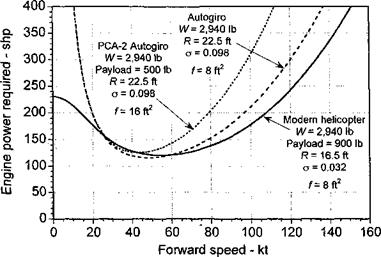Comparison of Autogiro Performance with the Helicopter
Consider now the power required for flight with an autogiro versus that for a helicopter of equivalent weight. Such a comparison helps show the relative disadvantage of the autogiro. This issue had not gone unnoticed by Cierva [see Bennett (1933, 1961)] and had been analyzed by von Karman (1931). The results in Fig. 12.11 show such a comparison for a PCA-2 autogiro versus a modem helicopter in the 3,000-lb weight class. It is clear the power requirements for flight are generally larger for the autogiro. The rapid increase in power required by the autogiro at higher airspeeds is significant. This is partly because of the typically high parasitic drag of an autogiro, as well as because the rotor operates at
|
Figure 12.11 Comparison of the power required for flight of a autogiro versus that of a helicopter. |
higher advance ratios (compared to a helicopter) with significant reverse flow and increased drag on the retreating side of the disk. However, with appropriate streamlining and general drag reduction it is also apparent that the power requirements for flight can be significantly reduced to values that are more consistent with a modem helicopter. The pay load of a modem helicopter is also nearly twice that which could be achieved with an early autogiro. Yet, the obvious mechanical simplicity of the autogiro suggests that with modem construction methods and materials, the empty weight fraction could be reduced and payload increased such that a modem autogiro might become an economically competitive means of achieving rotating-wing borne flight.












